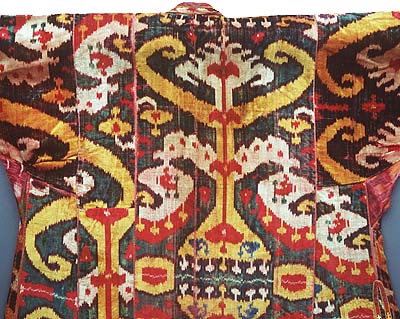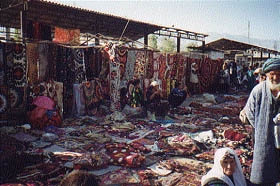|
The rivers that began in the mountains of Central Asia filtered
down onto the plains and created oases. Towns sprang up
at these oases as the Silk Road trade grew and flourished.
Travellers stopped for water, food and shelter and traded
with the oasis dwellers; in this way goods and ideas were
exchanged along the length of the Silk Road. The major urban
centres, like Bhukara and Samarkand, were organised as states
or khanates and were headed by a khan or chieftain. The
settled oasis dwellers were agriculturalists who produced
a range of agricultural goods, including grains, fruit,
nuts, cotton and silk. Many were also skilled craftspeople,
producing metalware, ceramics, and textiles such as ikats
and embroideries. These urban products were traded in the
bazaars for the nomads' animal products; meat and cheese,
and wool rugs and carpets.
Textile
arts of the urban oasis dwellers
Ikats
Among the best known textile arts produced in urban centres
of Central Asia are ikat-dyed silk, and silk and cotton robes
and panels. They were produced by men in workshops. As you
could see from the timeline, silk
made its way from China into Central Asia via the Silk Road
and was embraced by the settled artisans.
Pardah
(wall hangings) and men's and women's clothing were predominantly
made using ikat silks or abr (meaning cloud). To
make ikat, which is known locally as abrbandi, warp
threads are tie-dyed before weaving giving the distinctive
streaky appearance. There are two main types of ikat in
Central Asia:
- full
ikat: the entire warp is tie-dyed and the order of the
threads is set at the time of dyeing
- strip
ikat: long skeins are tie-dyed and the pattern is determined
by the way these are positioned on the loom, often alternating
with plain warps. (Sumner, 1999:30)
Clothing
All over Central Asia, men, women and children wear basically
the same thing: shirt/dress and trousers under a coat and
a hat. In the urban centres
…
ikat-patterned khalats were worn by both men
and women, mostly for ceremonial and ritual use…The
cut of these brightly coloured robes varied very little
but the materials they were made of, the structure of
the fabric and the manner of ornamentation were all
indicative of the wearer's status. The lowest ranks
wore robes of adras (silk and cotton), while
the highest wore silk velvet ikat, sometimes embellished
with goldwork embroidery. (Sumner, 1999:31)
An
essential part of Islamic women's dress was the paranja,
which is a veiling garment worn over the head. Strict adherence
to custom required that the hair and faces of women were
not seen in public.

Fig.
3 Detail of Man's khalat
Silk ikat velvet, embroidered cuffs, printed-cotton
lining, woven by Uzbek men in ukhara, about 1870. 1220
x 1425 mm 85/1439
Powerhouse Museum Collection. |
Embroidery
The other well known urban textile art of Central Asia is
the suzani. These are a range of silk on cotton embroidered
hangings of different sizes, featuring flowers or cosmological
symbols. Suzanis were used as wall hangings, bed covers
and room dividers and were made by women as dowry textiles.
Once a daughter was born, the women of the family began
to embroider suzanis for her dowry. The design was
drawn on the cloth by a senior woman of the family and embroidered
by several women. Once the embroidery was complete, it was
reassembled. Two of the main centres for these embroideries
were Bukhara and Samarkand, in what is now Uzbekistan.
The most common stitches were:
- chain
stitch, and
- basma
or Bukhara couching for filling.
 |
 |
|
Photo:
Christina Sumner
|
Photo:
Christina Sumner
|
Activity
- Read
the text on nomadic life. Identify the key factors affecting
the life of a nomad.
- Print
out the map of Central Asia and track the events identified
in the timeline on the map. The timeline
summarises the historical events and significant developments
in Central Asia and surrounding cultural centres.
|